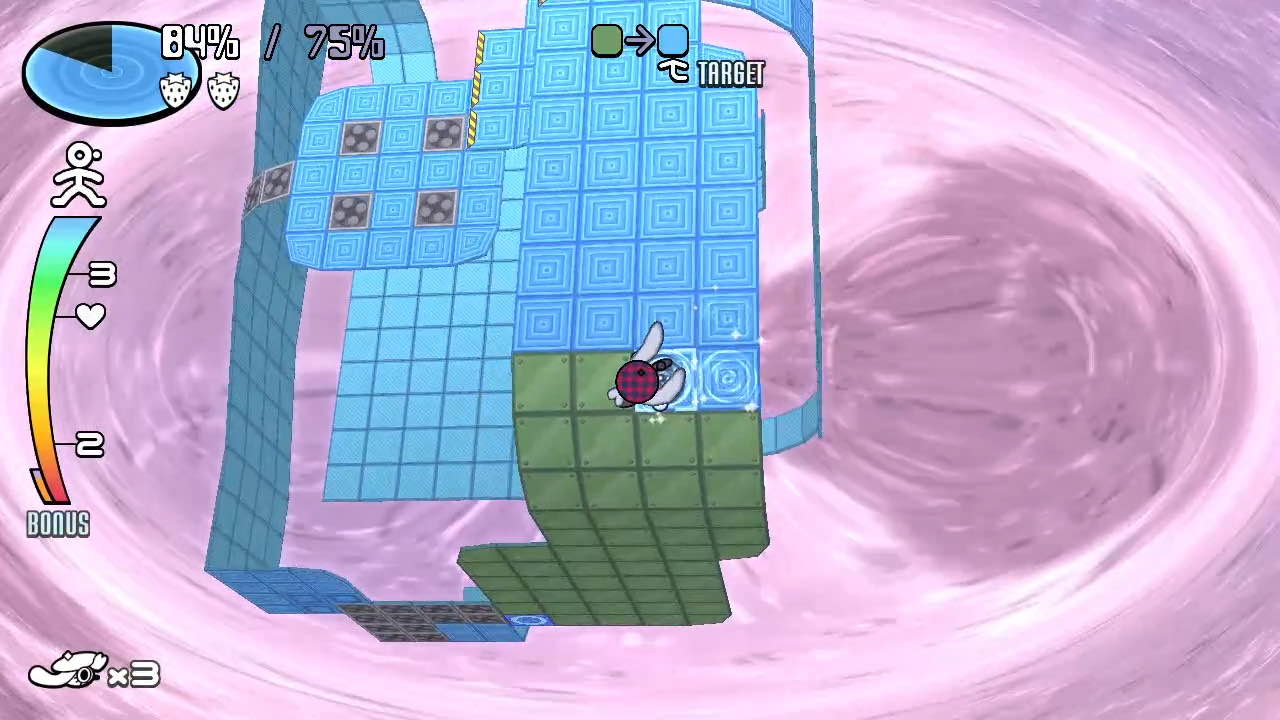Within a handful of stages and a mere five minutes of booting the game up, I knew Vividlope was special. Honestly, I think I knew from the first time I watched a trailer. I might be biased, of course; the words I’d use to help paint you a quick picture of Vividlope are basically a shortlist to describe one of my personal dream games:
- A fast-paced, arcadey action platformer with buttery smooth gameplay that feels like a 3-D take on Pacman
- High focus on replayability via high score chasing, three playable characters with distinct stats and abilities, multiple difficulty options, and a copious amount of unlocks
- Downright oozing with style that is inspired by games, media, and the general vibe from the turn of the millennium, including a soundtrack that half the time feels like composition from a lost entry in the Klonoa series and the other half the backing music to what I imagine an opium den sounds like (I swear that’s a compliment)
- Well over 100 levels, each with its own completely unique geometry and layout, to say nothing of the stage hazards themselves
- Dozens of enemies, each with unique designs and behaviours, complete with a fully interactive bestiary that serves double duty as a fully player-controlled training mode (a feature so forward-thinking for a game of this scope and scale that I was genuinely shocked to see it)
I present the broad strokes of Vividlope in this bullet point fashion, not to do it a disservice or attempt to quickly blast through writing a review before heading off to bed, but because of the type of game it is—simply put, I’m not going to be able to deliver you an in-depth summation of the themes presented in the story, because that’s just not the type of game it is.
Similarly, there’s only so much I can do to describe something as gameplay-centric as Vividlope when getting a controller in your hands would serve you so much better. As mentioned above, picture some kind of 3D Pacman mixed with the colour-changing tiles of Q*Bert, set on giant, abstract shapes that you rotate and manoeuvre your way around, and you’re already the majority of the way there. In each stage, your goal is to step on a certain amount of tiles to change their colours, and once a specific percentage of the tiles have reached the correct colour, there is a bonus phase where all enemies and power-ups disappear, and you’re left to attempt to clean up the mess you left behind and fill in as many of the remaining tiles as you can while taking care not to step on any already completed tiles.
Besides basic cardinal movement, the player character can also jump, which, while it can obviously act as a verb to avoid contact with enemies, is equally vital in your quest to avoid stepping on already converted tiles. Depending on the level, re-treading old ground can either “merely” ruin a high score attempt or cause you to reset an already changed tile back to its original state. The addition of offensive power-ups such as a hammer, ground pound, or dash that all act as attacks against enemies while simultaneously painting varying areas of tiles around you rounds out your verb set, as well as what you can largely expect from Vividlope.
Check out Matt and his wife talking exhaustively about Vividlope in the video below that they recorded for All N Media.
If I left it at that, Vividlope would still be one of the easiest recommendations for fans of the genre I could make, especially given the absurdly low price ($9.99 on the US eShop!) coupled with its wide breadth of content. But it’s the little details where you can really see and feel the humanity of the people who made it. When I think about how each game’s world opens up with an overly slick splash screen straight out of a 1999 interactive encyclopaedia CD-ROM, complete with unnecessarily large, reflective text and (for some reason) advice from a fortune cookie, I get a big goofy grin on my face. The first time I used the hammer powerup and whiffed because I was standing too close to a ledge and my mallet slammed down on nothing but air instead of curving around the game world like my character did, I had to actually pause the game and marvel at the attention to detail. And when I heard some melodramatic, echo-y sampled lines talking about “wavelengths resonating with another world” in a late game level’s D&B music straight from 2003 as I finally obtained an elusive S+ rank, I felt like the coolest person on earth. More importantly, I felt very connected with the developers and composers in a way I rarely ever have with any form of art. And that has to count towards something, right?
I get weird about handing out “perfect” review scores. Not that I think my opinion carries more weight than anyone else’s, or that I’m somehow more insightful and wise in the arcane art of submitting a numbered review score for a video game, of course. But I would like to think that this overly cautious approach when handing out those coveted 5 stars lends my words some extra oomph when it does happen. Just like I knew within a few minutes of starting the game that Vividlope was something special, I doubt it was more than an hour or two later that I knew it was a masterpiece, something unmissable for fans of arcade-styled puzzle games. I’ve already spent 20 hours with the game in an early review capacity, and I’d be shocked if I don’t put in triple that amount as I continue on in my hunt for perfect scores across every stage, figuring out which character I gel with best, and gathering the mental dexterity to tackle hard mode. Consider Vividlope required reading.
Release Date: August 8th, 2024
Platforms: Nintendo Switch & PC
Price: £8.99
Version Tested: Nintendo Switch
Many thanks to the publisher for the review copy











Comments
⚠️ Comments for this post are closed ⚠️